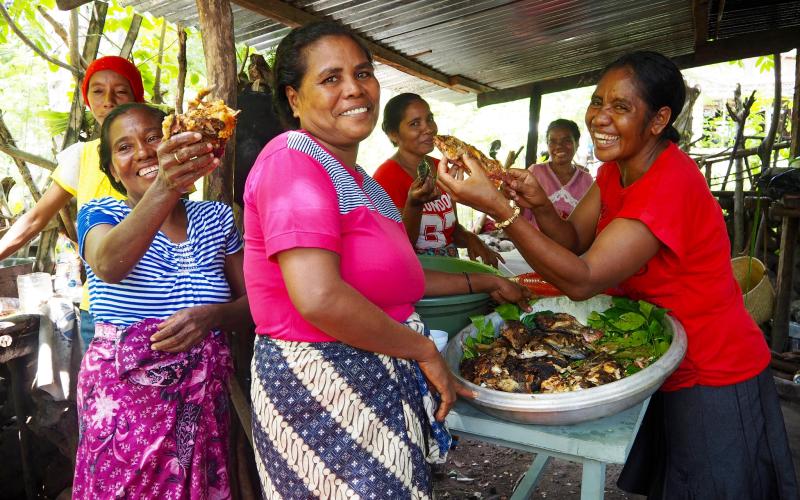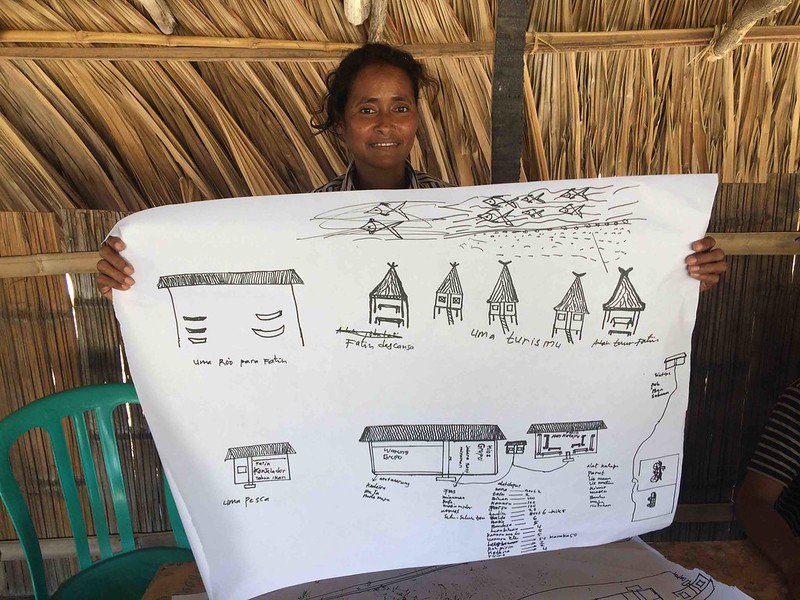
- Participatory approaches to development consider the needs, wants and aspirations of community members
- A livelihood-enhancement project in Timor-Leste sought to apply a participatory approach to allow communities to dictate actions and decision-making about their aquatic resources
- Though not without challenges, participatory approaches give communities a sense of ownership and responsibility over development initiatives
Fish-based livelihoods are the backbone of Pacific island economies, offering a critical source of food and income in rural communities. In Timor-Leste, government ministers and development partners are increasingly recognizing the contributions of fish and aquatic foods to nutritious diets and local economies, spurring new investments in the capture fisheries and aquaculture sector.
Historically, coastal communities have often been excluded from decision-making about resources they depend on for their livelihoods. Despite well-meaning intentions, external interventions may enforce a paternalistic view on community development. Initiatives based on outsiders’ priorities, which fail to adequately consider community perspectives and needs, tend to be short-sighted and overlook broader elements of well-being.
In contrast to the traditional top-down approach, a new WorldFish report documents and reviews the process of working closely with two community groups in coastal Timor-Leste to develop and implement ideas to improve their fish-based livelihoods.
The livelihood enhancement project aimed to harness the economic and nutritional value of the nation’s aquatic foods, but in such a way where community members decided which actions to implement and what support they required from the project.
When communities are encouraged to innovate and empowered to make decisions about their lives and resources, the development outcomes are often more appropriate and longer-lasting, explained Hampus Eriksson, the report’s co-author and a senior scientist at WorldFish.
The report ultimately concluded that while people in rural coastal communities are willing to experiment with ways to enhance their livelihoods, challenges remain in generating ideas, building skills to access urban markets and collaboration among group members.
“Sharing practical experiences from programs that deliberately take a community-led approach to development highlights the benefits and considerations of this method of planning in coastal communities. This report demonstrates what exactly happens when people share their ideas for development with external partners,” said Alexander Tilley, co-author and WorldFish senior scientist.
Evaluating challenges and successes

The project worked with community members in two coastal villages, Ililai and Beacou, to plan and implement a livelihood enhancement project in their respective communities over a four-year period.
Discussions were held with each community group to learn about their fisheries activities and to identify an idea for a new or improved livelihood activity. The idea was then evaluated by the community group using a participatory assessment tool.Following the assessment, WorldFish researchers worked with each group to implement their ideas and held regular discussions to reflect on project progress and adjust activities accordingly.
In Ililai, community members decided to construct and manage a Fish House, with aspirations to centralize fishing economic activities for the community, where fish could be landed ashore and sold onwards. As ideas evolved, the group resolved to establish a restaurant in the Fish House, which was to be managed by the women in the group. Its location was strategically selected near a main road to attract passing travellers.
Meanwhile, group members in Beacou agreed to establish a small business, or microenterprise, to develop two fish-based products for retail: bottled sardines and dried fish powder. This idea built on skills the women had learned from training provided by another organization.
Both groups successfully implemented their ideas with support from the project. The Ililai Fish House building was constructed by the group, and members attended training on business management and learned new aquatic food recipes to prepare. A restaurant was established in the Fish House, which remained self-sufficient following the departure of WorldFish staff. Several other roadside restaurants also sprung up in Ililai.
In Beacou, the project helped the group to source packaging materials and facilitated discussions with retail outlets in the nation’s capital, Dili. After initial pilot sales of both products, the group focused their efforts on the more popular and competitively priced dried fish powder. Over the course of the project, group members gradually took on responsibility to purchase supplies and deliver their retail products to the capital. Trading arrangements were established with several Dili retail outlets, with two restocking the product on multiple occasions.
"Building women's confidence to negotiate directly with urban traders and supermarkets in Dili was one of the more challenging aspects of the project," explained Agustinha Duarte, a WorldFish research analyst in Timor-Leste and co-author.
Both groups also encountered challenges in regard to working collectively, such as allocating duties and resolving disagreements. There were also some inherent tensions regarding gender norms between men and women in the community groups.
Yet in both cases, project activities ultimately enhanced the skills of group members and created new markets for fish-based products. Individual incomes generated were modest, but group members expressed their interest to continue and improve their businesses.
“Our product has been stocked in national shops, and we are very proud of that. We’re ready to supply other customers, although there are internal group weaknesses that must be addressed,” said Olinda Lagur, the Beacou community group leader.
Alternatives to top-down development

Across the Pacific region, government and aid-funded development programs have tended to focus on top-down approaches to sustainable development, such as building infrastructure or disseminating new technologies.
However, these initiatives are typically based on ‘outside’ or ‘expert’ priorities and overlook the needs and wants of community members, explained Duarte.
Alternatively, community-led development initiatives are based on community members' perspectives, who are the most suited to guide interventions as they best understand the situation on the ground and are most affected by the outcomes.
“The next challenge is to make these scattered grassroots initiatives have a bigger impact on development at scale and find a balance between locally led and externally supported development,” said Eriksson.
Creating links between other small-scale initiatives by documenting experiences and facilitating peer-to-peer sharing and the flow of information between coastal villages are possible approaches to be explored further in future work, he added.
While establishing new livelihood activities in rural communities is inherently complex, communities are more likely to adopt and sustain initiatives if they have a sense of ownership from the onset, the report’s authors ultimately concluded.
“Listening to the ideas of the people who catch, process and trade fish provides a strong foundation for an alternative and durable model of enhancing fish-based livelihoods for the benefit of rural communities,” said Tilley.
